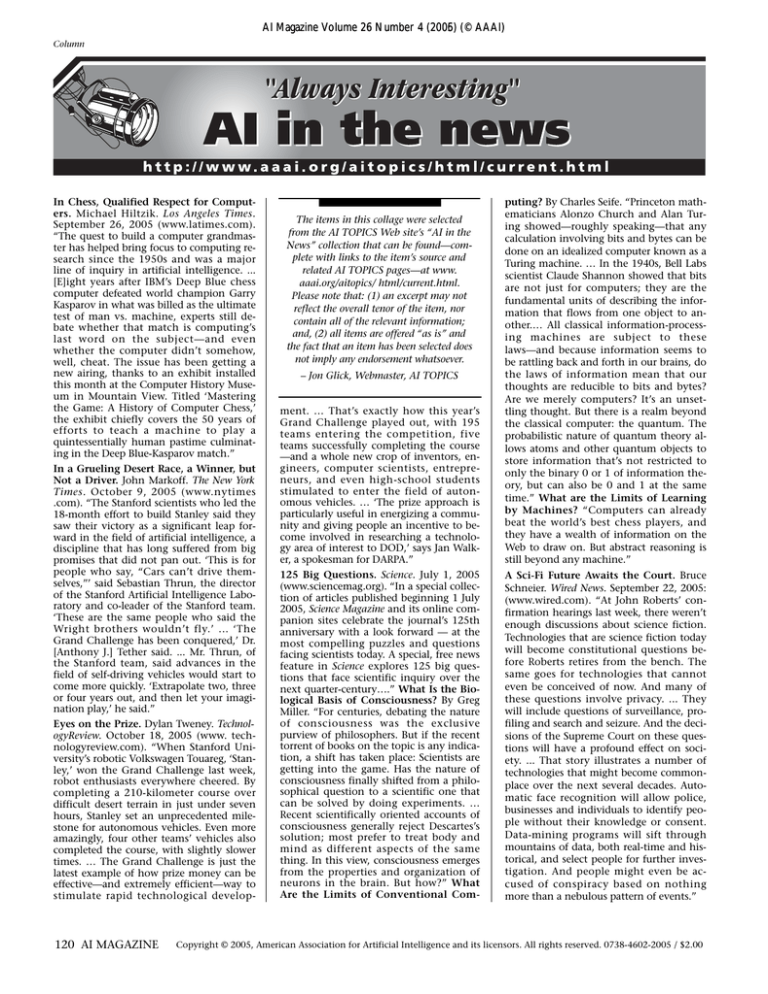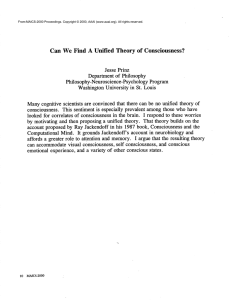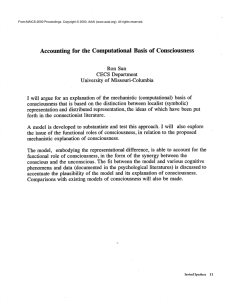
AI Magazine Volume 26 Number 4 (2005)
(2006) (© AAAI)
Column
In Chess, Qualified Respect for Computers. Michael Hiltzik. Los Angeles Times.
September 26, 2005 (www.latimes.com).
“The quest to build a computer grandmaster has helped bring focus to computing research since the 1950s and was a major
line of inquiry in artificial intelligence. ...
[E]ight years after IBM’s Deep Blue chess
computer defeated world champion Garry
Kasparov in what was billed as the ultimate
test of man vs. machine, experts still debate whether that match is computing’s
last word on the subject—and even
whether the computer didn’t somehow,
well, cheat. The issue has been getting a
new airing, thanks to an exhibit installed
this month at the Computer History Museum in Mountain View. Titled ‘Mastering
the Game: A History of Computer Chess,’
the exhibit chiefly covers the 50 years of
efforts to teach a machine to play a
quintessentially human pastime culminating in the Deep Blue-Kasparov match.”
In a Grueling Desert Race, a Winner, but
Not a Driver. John Markoff. The New York
Times. October 9, 2005 (www.nytimes
.com). “The Stanford scientists who led the
18-month effort to build Stanley said they
saw their victory as a significant leap forward in the field of artificial intelligence, a
discipline that has long suffered from big
promises that did not pan out. ‘This is for
people who say, “Cars can’t drive themselves,”’ said Sebastian Thrun, the director
of the Stanford Artificial Intelligence Laboratory and co-leader of the Stanford team.
‘These are the same people who said the
Wright brothers wouldn’t fly.’ ... ‘The
Grand Challenge has been conquered,’ Dr.
[Anthony J.] Tether said. ... Mr. Thrun, of
the Stanford team, said advances in the
field of self-driving vehicles would start to
come more quickly. ‘Extrapolate two, three
or four years out, and then let your imagination play,’ he said.”
Eyes on the Prize. Dylan Tweney. TechnologyReview. October 18, 2005 (www. technologyreview.com). “When Stanford University’s robotic Volkswagen Touareg, ‘Stanley,’ won the Grand Challenge last week,
robot enthusiasts everywhere cheered. By
completing a 210-kilometer course over
difficult desert terrain in just under seven
hours, Stanley set an unprecedented milestone for autonomous vehicles. Even more
amazingly, four other teams’ vehicles also
completed the course, with slightly slower
times. … The Grand Challenge is just the
latest example of how prize money can be
effective—and extremely efficient—way to
stimulate rapid technological develop-
120 AI MAGAZINE
The items in this collage were selected
from the AI TOPICS Web site’s “AI in the
News” collection that can be found—complete with links to the item’s source and
related AI TOPICS pages—at www.
aaai.org/aitopics/ html/current.html.
Please note that: (1) an excerpt may not
reflect the overall tenor of the item, nor
contain all of the relevant information;
and, (2) all items are offered “as is” and
the fact that an item has been selected does
not imply any endorsement whatsoever.
– Jon Glick, Webmaster, AI TOPICS
ment. … That’s exactly how this year’s
Grand Challenge played out, with 195
teams entering the competition, five
teams successfully completing the course
—and a whole new crop of inventors, engineers, computer scientists, entrepreneurs, and even high-school students
stimulated to enter the field of autonomous vehicles. … ‘The prize approach is
particularly useful in energizing a community and giving people an incentive to become involved in researching a technology area of interest to DOD,’ says Jan Walker, a spokesman for DARPA.”
125 Big Questions. Science. July 1, 2005
(www.sciencemag.org). “In a special collection of articles published beginning 1 July
2005, Science Magazine and its online companion sites celebrate the journal’s 125th
anniversary with a look forward — at the
most compelling puzzles and questions
facing scientists today. A special, free news
feature in Science explores 125 big questions that face scientific inquiry over the
next quarter-century….” What Is the Biological Basis of Consciousness? By Greg
Miller. “For centuries, debating the nature
of consciousness was the exclusive
purview of philosophers. But if the recent
torrent of books on the topic is any indication, a shift has taken place: Scientists are
getting into the game. Has the nature of
consciousness finally shifted from a philosophical question to a scientific one that
can be solved by doing experiments. …
Recent scientifically oriented accounts of
consciousness generally reject Descartes’s
solution; most prefer to treat body and
mind as different aspects of the same
thing. In this view, consciousness emerges
from the properties and organization of
neurons in the brain. But how?” What
Are the Limits of Conventional Com-
puting? By Charles Seife. “Princeton mathematicians Alonzo Church and Alan Turing showed—roughly speaking—that any
calculation involving bits and bytes can be
done on an idealized computer known as a
Turing machine. … In the 1940s, Bell Labs
scientist Claude Shannon showed that bits
are not just for computers; they are the
fundamental units of describing the information that flows from one object to another.… All classical information-processing machines are subject to these
laws—and because information seems to
be rattling back and forth in our brains, do
the laws of information mean that our
thoughts are reducible to bits and bytes?
Are we merely computers? It’s an unsettling thought. But there is a realm beyond
the classical computer: the quantum. The
probabilistic nature of quantum theory allows atoms and other quantum objects to
store information that’s not restricted to
only the binary 0 or 1 of information theory, but can also be 0 and 1 at the same
time.” What are the Limits of Learning
by Machines? “Computers can already
beat the world’s best chess players, and
they have a wealth of information on the
Web to draw on. But abstract reasoning is
still beyond any machine.”
A Sci-Fi Future Awaits the Court. Bruce
Schneier. Wired News. September 22, 2005:
(www.wired.com). “At John Roberts’ confirmation hearings last week, there weren’t
enough discussions about science fiction.
Technologies that are science fiction today
will become constitutional questions before Roberts retires from the bench. The
same goes for technologies that cannot
even be conceived of now. And many of
these questions involve privacy. ... They
will include questions of surveillance, profiling and search and seizure. And the decisions of the Supreme Court on these questions will have a profound effect on society. ... That story illustrates a number of
technologies that might become commonplace over the next several decades. Automatic face recognition will allow police,
businesses and individuals to identify people without their knowledge or consent.
Data-mining programs will sift through
mountains of data, both real-time and historical, and select people for further investigation. And people might even be accused of conspiracy based on nothing
more than a nebulous pattern of events.”
Copyright © 2005, American Association for Artificial Intelligence and its licensors. All rights reserved. 0738-4602-2005 / $2.00








